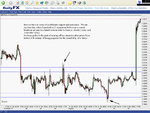Quite right DB, I've gone a bit Maxim mad, sorry for that!
I'm not confident enough to reverse if incorrect on a trade. If I'm in doubt I get out and then re-evaluate the position. If a reverse is required then I'll do so.
I guess my trading plan isn't set-up for reversing as I tend to chart different time frames for an equity and only trade in the direction of the trend of the longer timeframe. I generally have 2 stops one mental and one physical. The physical stops are generally placed at extreme areas where my outlook for the equity would change e.g. Bullish to neutral. These stops are "emergency stops" and are very rarely hit. It's peace of mind if you like. My mental stop is placed much nearer my trade entry and tells me if hit I'm wrong on the trade. I always prefer closing the trade at my mental stop and once in a trade the market will tell me if I'm right or not e.g. If I'm bullish and buy I like to see the market confirm my bullishness by going up in the next few bars of the timepoint i'm trading. If I buy and then the market goes dead or drops this indicates that although still Bullish the market may need to drop further still in order to find demand so I'll exit and wait for the next opportunity. This is why I try and enter trades near S/R as it gives me great mental stops which are close to the market. The smaller the stops the less I'll loose, the less I loose the more chance I have of making money out of my profitable trades.
I'm not confident enough to reverse if incorrect on a trade. If I'm in doubt I get out and then re-evaluate the position. If a reverse is required then I'll do so.
I guess my trading plan isn't set-up for reversing as I tend to chart different time frames for an equity and only trade in the direction of the trend of the longer timeframe. I generally have 2 stops one mental and one physical. The physical stops are generally placed at extreme areas where my outlook for the equity would change e.g. Bullish to neutral. These stops are "emergency stops" and are very rarely hit. It's peace of mind if you like. My mental stop is placed much nearer my trade entry and tells me if hit I'm wrong on the trade. I always prefer closing the trade at my mental stop and once in a trade the market will tell me if I'm right or not e.g. If I'm bullish and buy I like to see the market confirm my bullishness by going up in the next few bars of the timepoint i'm trading. If I buy and then the market goes dead or drops this indicates that although still Bullish the market may need to drop further still in order to find demand so I'll exit and wait for the next opportunity. This is why I try and enter trades near S/R as it gives me great mental stops which are close to the market. The smaller the stops the less I'll loose, the less I loose the more chance I have of making money out of my profitable trades.



